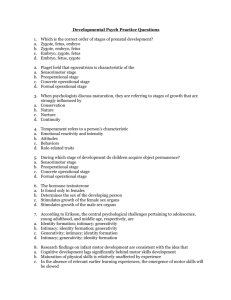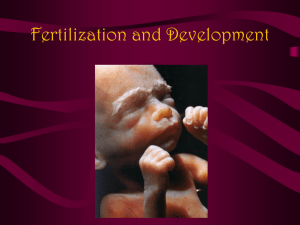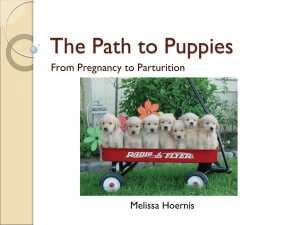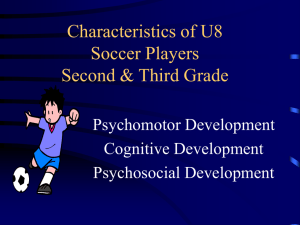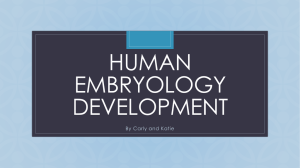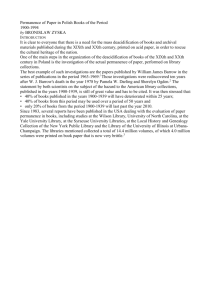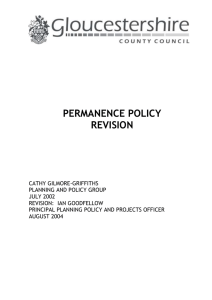is the awareness that objects exist even when they cannot be
advertisement
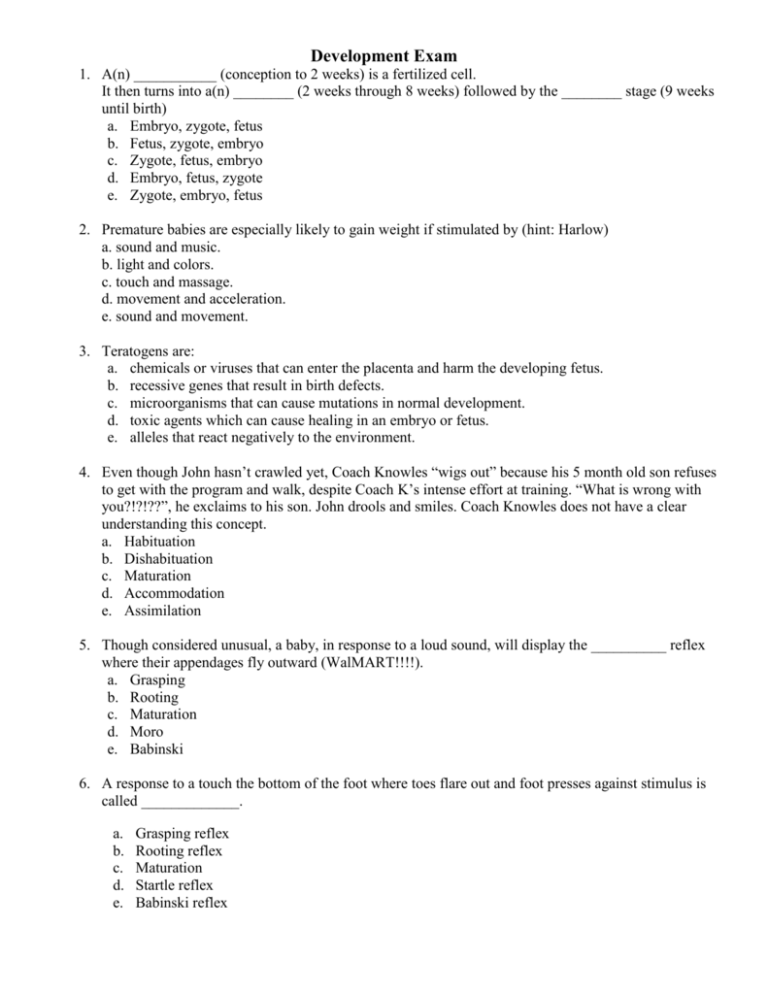
Development Exam 1. A(n) ___________ (conception to 2 weeks) is a fertilized cell. It then turns into a(n) ________ (2 weeks through 8 weeks) followed by the ________ stage (9 weeks until birth) a. Embryo, zygote, fetus b. Fetus, zygote, embryo c. Zygote, fetus, embryo d. Embryo, fetus, zygote e. Zygote, embryo, fetus 2. Premature babies are especially likely to gain weight if stimulated by (hint: Harlow) a. sound and music. b. light and colors. c. touch and massage. d. movement and acceleration. e. sound and movement. 3. Teratogens are: a. chemicals or viruses that can enter the placenta and harm the developing fetus. b. recessive genes that result in birth defects. c. microorganisms that can cause mutations in normal development. d. toxic agents which can cause healing in an embryo or fetus. e. alleles that react negatively to the environment. 4. Even though John hasn’t crawled yet, Coach Knowles “wigs out” because his 5 month old son refuses to get with the program and walk, despite Coach K’s intense effort at training. “What is wrong with you?!?!??”, he exclaims to his son. John drools and smiles. Coach Knowles does not have a clear understanding this concept. a. Habituation b. Dishabituation c. Maturation d. Accommodation e. Assimilation 5. Though considered unusual, a baby, in response to a loud sound, will display the __________ reflex where their appendages fly outward (WalMART!!!!). a. Grasping b. Rooting c. Maturation d. Moro e. Babinski 6. A response to a touch the bottom of the foot where toes flare out and foot presses against stimulus is called _____________. a. b. c. d. e. Grasping reflex Rooting reflex Maturation Startle reflex Babinski reflex Development Exam 7. This reflex a newborn moves head and mouth toward the source of touch a. Grasping b. Rooting c. Moro d. Startle e. Babinski Piaget 8. Seeing and thinking of the world only from one’s own standpoint is called ______________ thinking. a. Egocentric b. Object permanence c. Schema d. Socialization e. Sublimation 9. When a child realizes that an object continues to exist even though it cannot be seen or touched, the child is demonstrating the concept of ____. a. conservation b. object permanence c. assimilation d. accommodation e. imprinting 10. To understand the world, children construct ___________, or mental representations of the world. a. Egocentrism b. Object permanence c. Schema d. Socialization e. Sublimation 11. (Moose Prequel) In the ever continuing saga of Gabrielle, she sees a cow for the first time calls it a "doggie." This illustrates the process of: a. accommodation. b. object permanence. c. conservation. d. reversible thinking. e. assimilation. 12. In an effort to see a child cry, Isaac decided to torture one of his nephews. Isaac took a hot dog and cut it into 4 pieces and gave it to his nephew and then cut his hot dog into 8 pieces. Isaac then pointed out he had more than his nephew and laughed. His nephew burst into tears. This illustrates, besides the evilness of Isaac, the concept of: a. object permanence b. conservation. c. assimilation. d. accommodation. e. theory of mind Development Exam 13. When a child can understand abstract ideas, they have reached this cognitive stage? a. b. c. d. e. concrete operations preoperational sensorimotor formal operations conservation 14. According to Piaget, when a child cannot do mental operations, but understands object permanence, they have reached this cognitive stage? a. concrete operations b. preoperational c. sensorimotor d. formal operations e. conservation 15. Renee Baillergeon discovered that by showing possible and impossible outcomes that non verbal infants a. understand the basic laws of physics b. are capable of addition and subtraction c. understand the basic properties of objects d. are capable of conservation e. are able to perform some concrete operational thought. 16. The first time that 4 year old Sarah saw her older brother play a flute, she thought it was simply a large whistle. After her mother told it was called a flute, Sarah said flute next time she saw this. Sarah expanded her understanding of a flute best illustrates the process of a. conservation b. object permanence c. assimilation d. accommodation e. imprinting 17. During the sensorimotor stage of cognitive development, a child’s relations with the world are through a. logical reasoning b. physical interaction c. abstract operations d. explanations given by authority figures e. preoperational functioning 18. 5-year old Sally predicts that Anne has taken her ball and put it in her (Anne’s) cupboard. She has seen Anne do this before with other children. This is an example of ____________. a. theory of mind. b. theory of thought. c. theory of assimilation d. theory of accommodation e. theory of schemas. Development Exam Attachment/Parenting 19. _________ is the fear of strangers that develops at around 8 months. Infants form schemas for familiar faces and cannot __________ a new face a. Attachment disorder; assimilate b. Stranger anxiety; accommodate c. Insecure attachment; assimilate d. Stranger anxiety; assimilate e. Insecure attachment; accommodate 20. Separation anxiety peaks at _____ months of age, regardless of whether the children are home or sent to day care. a. 8 b. 11 c. 12 d. 13 e. 14 21. When an attachment figures is not responsive their children, those children will have a hierarchy of attachment behaviors develop due to increasing fear and anxiety. Which behavior on this list is NOT part of this hierarchy a. Visual checking b. Signaling to re-establish contact c. Calling and Pleading d. Withdrawn e. Moving to re-establish contact 22. In _________________, adult develop a parenting style in which children participate in decisions affecting their lives. a. Democratic families b. Authoritative families c. Permissive families d. Laissez-faire families e. Authoritarian families 23. In _________________, adults are the bosses and children have no right to question their parents. a. Democratic families b. Authoritarian families c. Permissive families d. Authoritative families e. Laissez-faire families Erikson 24. According to Erik Erikson’s Psychosocial Stages of Development, adolescence must deal with the psychosocial conflict of: a. intimacy vs. isolation b. identity vs. role confusion. c. industry vs. inferiority. d. initiative vs. guilt. e. autonomy vs. shame and doubt Development Exam 25. The second stage of Erikson’s psychosocial stages is called: a. Identity vs Role confusion b. Trust vs Mistrust c. Generativity vs Stagnation d. Autonomy vs Shame and Doubt e. Initiative vs Guilt 26. According to Erik Erikson’s Psychosocial Stages of Development, young adults must deal with the psychosocial conflict of: a. trust vs. mistrust. b. identity vs. role confusion. c. industry vs. inferiority. d. initiative vs. guilt. e. intimacy vs. isolation 27. Coach Knowles is experiencing another mid life crisis. He purchases a Harley and hits the highways. BORN TO BE WILD!!!!! What stage of psychosocial development is Knowles having difficulties with? a. Identity vs Role confusion b. Trust vs Mistrust c. Generativity vs Stagnation d. Autonomy vs Shame and Doubt e. Initiative vs Guilt Kohlberg 28. Jamie does not steal a candy bar from the store because he is afraid his mother will spank him if he is caught. Jamie best represents a(n) _____ morality. a. preoperational b. preconventional c. conventional d. postconventional 29. According to Kohlberg’s theory of moral development, following the “letter of the law” is a. called conventional morality. b. called postconventional morality. c. the highest level of morality. d. difficult for adolescents. e. preconventional morality. 30. Compared with adults from Western cultures that favor individualism, those from communal societies are less likely to develop ____________ morality. a. preconventional b. postconventional c. concrete operational d. conventional e. preoperational Development Exam Freud 31. According to Freud, the most important erogenous zone during earliest infancy consists of the: a. eyes. b. mouth. c. bowels. d. breasts. e. genitals. 32. According to Freud, children develop unconscious sexual desires for the parent of the opposite sex during the _______ stage. a. oral b. genital c. phallic d. anal e. latency 33. When she was 8 years old, Inge was sexually abused by her uncle. At 14, Inge felt uncomfortable whenever she saw this uncle but was unable to understand why she felt this way. A psychoanalyst would be most likely to suggest that Inge is using the defense mechanism of: a. repression. b. reaction formation. c. rationalization. d. regression. e. displacement. 34. Freud referred to a lingering focus of pleasure-seeking energies at an earlier psychosexual stage as: a. reaction formation. b. projection. c. fixation. d. displacement. e. repression. 35. Coach Knowles makes you so mad you go home and yell at your mama (probably not smart either). What is this an example of: a. Reaction formation b. Regression c. Sublimation d. Denial e. Displacement 36. Thinking that your spouse wants to cheat on you when it is you that really want to cheat. a. Sublimation b. Repression c. Projection d. Reaction Formation e. Fixation Development Exam 37. “I didn’t want to go to that college anyway. It’s too expensive.” What defense mechanism is this an example of? a. Reaction formation b. Regression c. Rationalization d. Denial e. Displacement 38. Re-channel their unacceptable impulses towards more acceptable or socially approved activities. a. Reaction formation b. Regression c. Sublimation d. Denial e. Displacement Adolescences 39. An adolescent’s occasional impulsive and immature behavior is at least partly a reflection of the last brain area to mature, the: a. frontal cortex. b. temporal lobes. c. sensory cortex. d. parietal lobes. e. motor cortex 40. Traits such as breasts and hips in girls and facial hair and deepening of voice in boys develop. Pubic hair and armpit hair grow in both sexes. a. Puberty b. Primary Sexual Characteristics c. Secondary Sexual Characteristics d. Reproductive characteristics e. Adolescences KEEP Going 41-49 below Development Exam A. B. C. D. E. F. G. H. I. J. Rovee-Collier Baillargeon Bandura Deloache Harlow (A&B)Lorenz (A&C)Vygotsky (A&D)Ainsworth (A&E)Wynn (B&C)Gilligan 41. This psychologists suggested the way that adults use language and gestures and the child's experience through social interactions are very influential on cognitive development. 42. This psychologist studied symbols systems in children by using little snoopy and big snoopy 43. This psychologist studied object permanence in child as young as 3 months in age with this experiment. 44. This researcher one of the first to study imprinting, strong attachment for certain animals during an early-life critical period. 45. Children can also count. This researcher showed that children stared longer at the wrong number of objects than the right ones. 46. Who was the psychologist who designed the “strange situation”: a lab experiment with 8 different episodes of separation and reunion 47. This psychologist stated, in response to Kohlberg, that orientations for men and women arise from rational experiences of inequality and attachment 48. This psychologist showed children imitated novel behaviors with high frequency & precision without any reinforcements, prompts or instructions. 49. This researcher showed that infants bond with surrogate mothers because of bodily contact and not because of nourishment. 50. This researcher showed babies can learn and remember that foot movement moves the mobile. On back of scantron list (In order) 5 stages of Freud’s Psychosexual stages 8 Psychosocial stages 4 Stages of Piaget’s cognitive development
